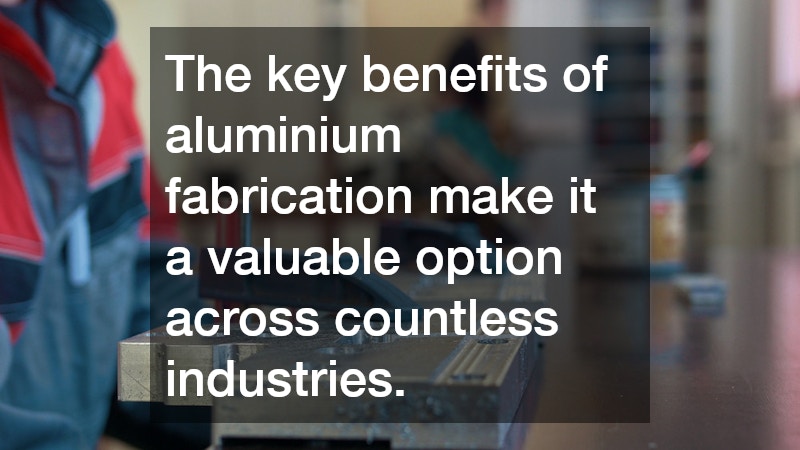Aluminium fabrication has become a vital process in modern construction, manufacturing, and industrial design. Known for its versatility, strength, and lightweight nature, aluminium is increasingly favoured across various sectors, including automotive, aerospace, building, and consumer goods.
This method involves shaping aluminium through cutting, bending, and assembling to create durable structures or components. As industries continue to pursue efficient and sustainable solutions, the popularity of aluminium fabrication continues to grow. Understanding the key benefits of this process helps businesses and consumers alike make informed decisions for their next project.
Exceptional Strength-to-Weight Ratio
One of the most significant benefits of aluminium fabrication is the material’s outstanding strength-to-weight ratio. Aluminium is significantly lighter than steel, yet it can be engineered to provide comparable levels of strength. This makes it an ideal choice for applications that require structural integrity without excessive weight. In sectors like automotive and aerospace, this characteristic leads to improved fuel efficiency and better performance due to reduced overall mass. In building and construction, lighter materials make for easier transportation and installation, reducing labour demands and equipment costs while still meeting performance expectations.
Corrosion Resistance for Longevity
Aluminium naturally forms a protective oxide coating when exposed to air, which acts as a barrier against corrosion. This resistance is particularly beneficial in harsh environments, such as coastal regions or industrial settings where exposure to moisture and chemicals is common. Structures and components made using aluminium fabrication tend to require less maintenance and exhibit longer lifespans compared to those made with other metals. This durability results in long-term cost savings and minimises the need for replacements or repairs, making aluminium an economically and environmentally sound choice.
Design Versatility & Aesthetic Appeal
Aluminium fabrication allows for a high degree of customisation, enabling the creation of complex and intricate shapes without compromising strength or stability. The metal is highly malleable, which means it can be extruded, welded, or machined into virtually any configuration. Designers and architects frequently take advantage of this flexibility to develop unique forms and sleek finishes that meet both functional and aesthetic goals. Additionally, aluminium’s ability to accept a range of surface treatments, such as anodising or powder coating, enhances its appearance while also providing extra protection. This makes aluminium a top pick for modern architectural facades, customised signage, and interior design elements.
Sustainability & Environmental Impact
Sustainability is a key consideration in today’s manufacturing landscape, and aluminium fabrication aligns well with eco-conscious goals. Aluminium is 100 percent recyclable without losing its inherent qualities. The recycling process uses only a fraction of the energy required to produce new aluminium from raw materials, resulting in a lower carbon footprint. By choosing fabricated aluminium components, businesses and builders contribute to the circular economy, reducing waste and conserving resources. In large-scale applications like commercial buildings or transport systems, this environmental benefit is compounded, supporting green building certifications and sustainability targets.
Thermal & Electrical Conductivity
Another notable benefit of aluminium fabrication is the metal’s excellent conductivity. Aluminium is widely used in electrical systems because of its ability to efficiently carry current with relatively low weight. In addition, its thermal conductivity allows for effective heat dissipation, making it suitable for components like heat sinks, lighting systems, and HVAC units. These properties are advantageous in both industrial and residential settings, enabling performance enhancements across a variety of technologies. The application of fabricated aluminium parts in such contexts improves system reliability and reduces energy consumption.
Cost-Effectiveness in Production & Maintenance
When compared to other metals, aluminium is generally more cost-effective throughout its lifecycle. Although the upfront cost may be higher than some alternatives, the reduced labour, transport, and maintenance expenses often result in a lower total cost of ownership. Aluminium fabrication allows for precise production techniques that reduce material waste and speed up manufacturing timelines. For industries that require high-volume production or rapid prototyping, these efficiencies translate to significant savings. Moreover, the durability and corrosion resistance of aluminium ensure fewer repairs and replacements over time, which further contributes to economic benefits.
Safety & Non-Toxic Properties
Aluminium is non-toxic and non-combustible, making it a safe choice for use in environments where fire resistance and hygiene are essential. In commercial kitchens, hospitals, and food processing facilities, aluminium surfaces are preferred due to their ease of cleaning and resistance to bacteria. The fabrication process can also include features that enhance safety, such as rounded edges, custom finishes, and reinforced supports. This makes aluminium an ideal option for both functional and decorative applications in public and private spaces, where health and safety standards must be met.
A Smart Choice for Modern Applications
The key benefits of aluminium fabrication make it a valuable option across countless industries. From its lightweight strength and resistance to corrosion, to its versatility, sustainability, and cost-efficiency, aluminium meets a broad range of performance and design requirements. As global markets increasingly demand materials that are efficient, durable, and environmentally responsible, aluminium fabrication stands out as a smart and future-ready solution. Whether you’re planning a new construction project, developing consumer products, or enhancing industrial infrastructure, incorporating aluminium into your fabrication strategy offers both immediate and long-term advantages.


